GVM and the value of choosing carefully
This is a subset of the keeping it legal article, and it’s really about looking at careful choices can let you be more appropriately under the Jimny’s gross vehicle mass (GVM), be it standard or upgraded GVM rating. For markets other than Australia this is the maximum vehicle weight.
GVM is probably one of the most heated areas of debate: some people insist you cannot possibly accessorise a Jimny without exceeding the factory GVM, and others say you absolutely can but it requires careful choices.
Sections
- What are the limits?
- How do I know if I’m exceeding the maximum weight?
- Weighing the car
- Calculating what it might weigh
- Choices you can make to help out
What are the limits?
I’ll start with some definitions of terms as it will help you build an understanding of all these numbers I am throwing around.
Tare weight for Australian compliance is the weight of the vehicle, ready to drive but with only 10 L of fuel aboard. I don’t really know why they do it this way, but that’s the compliance weight of the car.
Kerb weight is the weight that the car would be fully fuelled and parked up ready to go at the side of the road. This is, if you want, the base weight before any person gets into the car.
GVM (gross vehicle mass) is the maximum weight that the vehicle can be on the road and still be legal. Exceeding this and you potentially are getting turned around and/or a fine and/or if there’s an issue related to being over weight then maybe an accident won’t be covered by insurance.
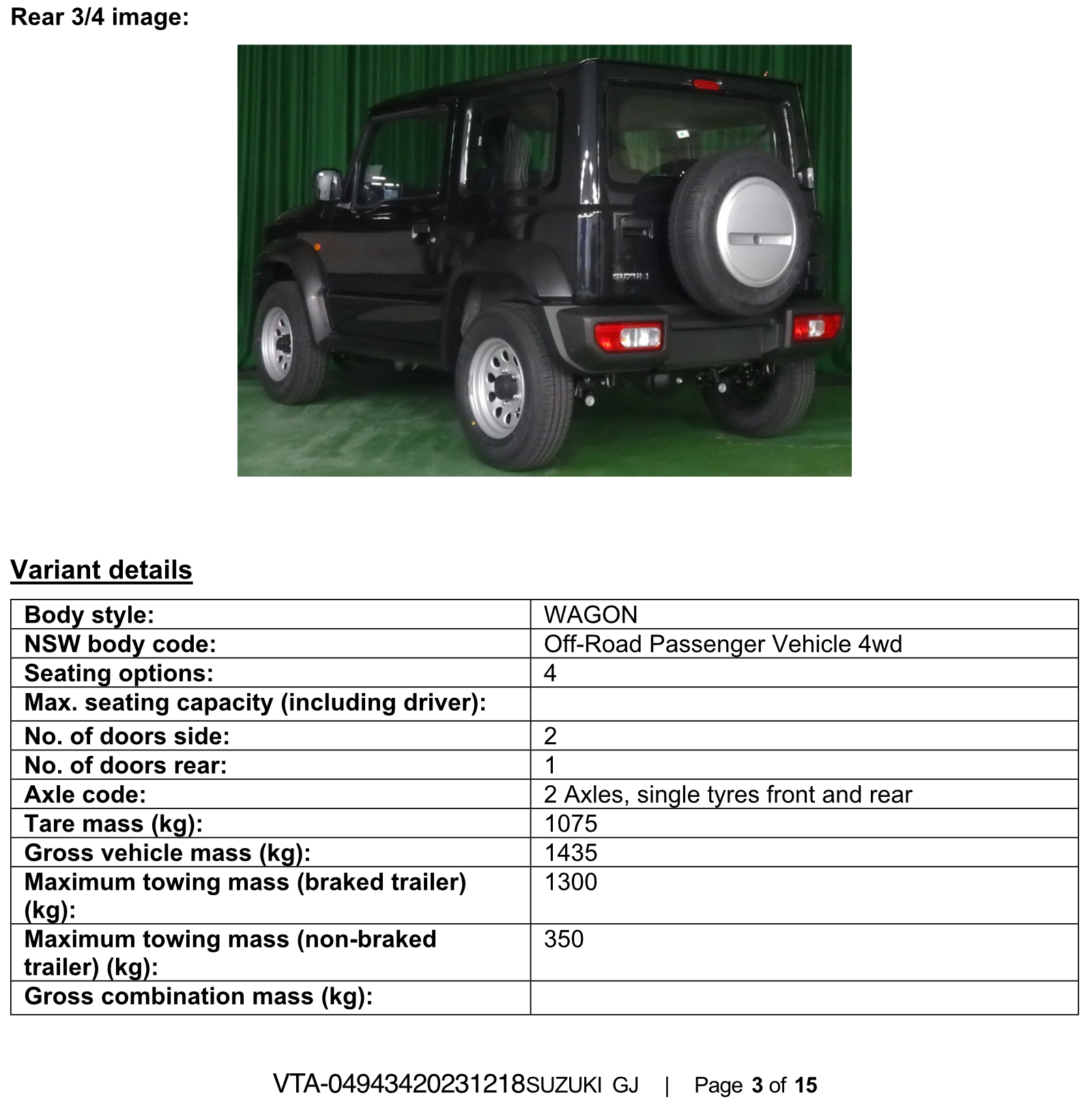
Axle load limit is the forgotten number for a Jimny. This is the maximum load on either the front of the back wheels. It is specified in the owners manual but isn’t captured as part of the compliance information. Really heavy front accessories e.g. bullbar will impact the front axle load, and towing impacts the rear axle load limit. Loads in the boot will more impact the rear than the front but it depends how far forwards of the rear axle it is. A GVM upgrade modifies the axle load limit along with the total maximum weight of the vehicle.
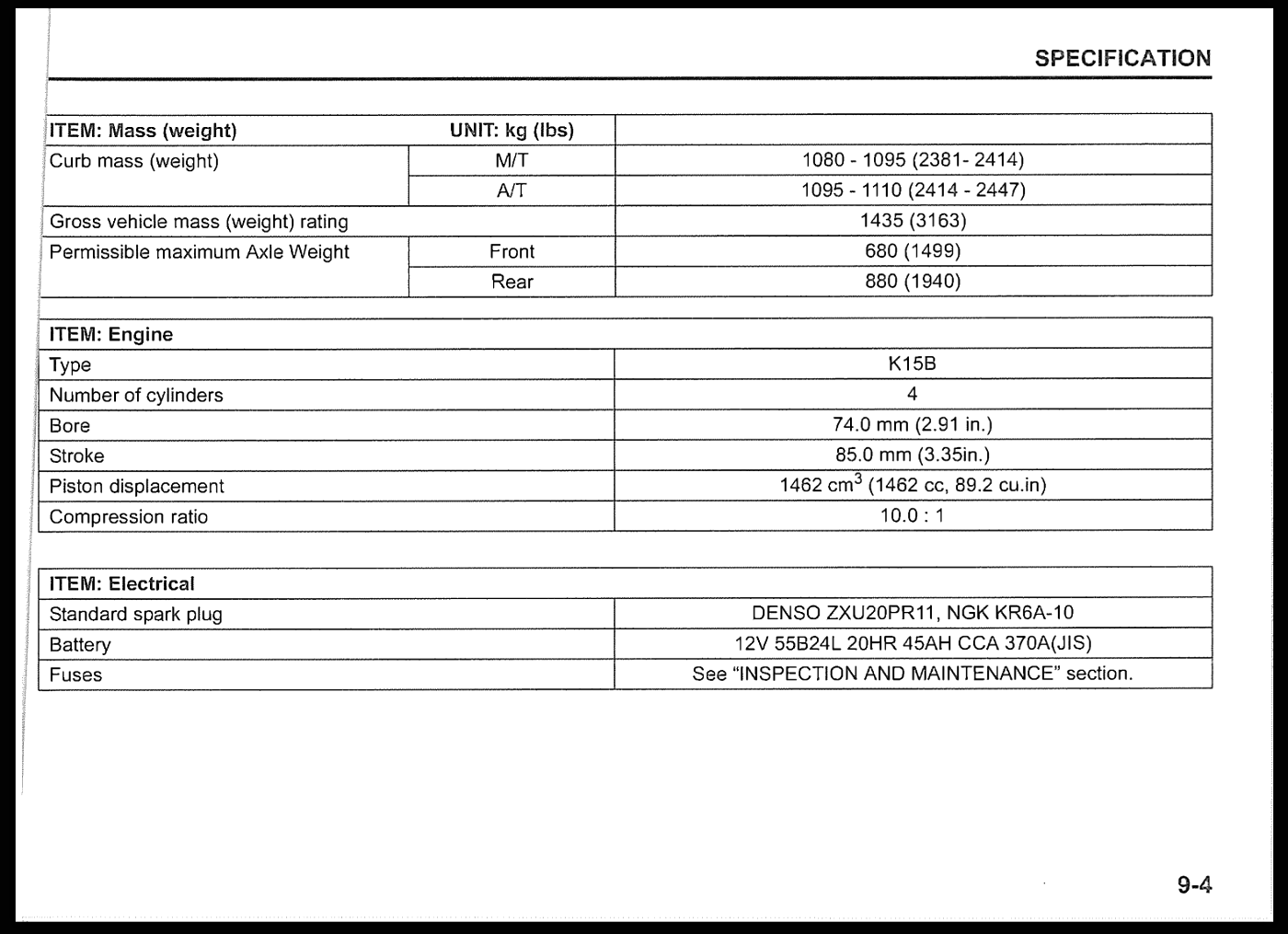
Note that the axle load limits are the same between the Ironman and Tough Dog/TJM GVM upgrades for the 3 door: 880 kg front axle load limit, 1100 kg rear axle load limit. This is despite the Ironman GVM upgrade featuring a 15 kg lower GVM than the other two options. Ultimately the axle load limit adds up to higher than a GVM usually as it allows for variation in attitude of the car e.g. pointing up or down a hill and therefore more or less load going on one axle.
This following table uses the official compliance figures provided by ROVER. Note that automatic transmissions are specified to weigh differently in the 3 and 5 doors but they do weigh and have the same stuff. Autos are +15 kg on the base weight, and the 5 door is +102 kg over a 3 door.
| 3 door Aus compliance (VTA-049434), manual | 3 door Aus compliance (VTA-049434), auto | 5 door XL Aus compliance (VTA-061645), manual | 5 door XL Aus compliance (VTA-061645), auto | |
|---|---|---|---|---|
| Tare weight | 1075 kg | 1090 kg | 1177 kg | 1192 kg |
| Kerb weight (tare + 30L fuel) | 1095 kg | 1110 kg | 1197 kg | 1212 kg |
| GVM | 1435 kg | 1435 kg | 1545 kg | 1545 kg |
| Front axle load | 680 kg | 680 kg | 765 kg | 765 kg |
| Rear axle load | 880 kg | 880 kg | 880 kg | 880 kg |
GVM upgrade is a method to change the maximum vehicle weight and it’s a uniquely Australian thing to do. While it doesn’t require a suspension lift, all routes to do so legally involve changes to the suspension which includes a suspension lift. In fact, all three options that are applicable nation-wide (through Ironman, Tough Dog or TJM) for the 3 door Jimny are the exact same suspension lifts as they offer, but come with added cost covering the engineering paperwork to have the maximum weight of the vehicle increased. There is also an option to increase the GVM in Queensland to the sum of the axle load limits (explained below) which gives you a small boost, less than the other options. At the time of writing (September 2024) there’s no nationally approved route for a GVM upgrade for a 5 door Jimny.
There are some challenges to a GVM upgrade, e.g. depending on which state you are in and the way you have had it applied (either pre or post registration) then you might be limited to things like the standard tyre and wheel sizes. You also have to keep to the suspension brand used for the upgrade, so you can’t mix and match springs/shock absorbers and the like if you want different ride characteristics.
Payload is the weight difference between the gross vehicle mass and the kerb weight, that is, it’s the amount of ‘stuff’ you can put into a fully fuelled car and still be at or under the maximum weight for the vehicle. As the transmission choice and number of doors dictates the kerb weight of the car, the payload will vary by these factors. Manual cars are 15 kg lighter than automatics, so they have a 15 kg higher payload. Also note, however, the gross vehicle mass along with the base weight varies by number of doors: a 5 door Jimny has a payload 8 kg heavier than an equivalent 3 door Jimny as the gross vehicle mass increases a teeny bit higher than the kerb weight increases over the 3 door. If you have elected to add a gross vehicle mass upgrade to your car then your payload will depend on this, too.
Once you account for transmission and variations in GVM, here’s the relevant payloads:
| 3 door manual (kerb weight 1095 kg) | 3 door auto (kerb weight 1110 kg) | 5 door manual (kerb weight 1197 kg) | 5 door auto kerb weight 1212 kg) | |
|---|---|---|---|---|
| Standard | 340 kg | 325 kg | 348 kg | 333 kg |
| Queensland only sum of axle load limit GVM upgrade (3 door 1560 kg, 5 door 1645 kg) | 465 kg | 450 kg | 448 kg | 433 kg |
| Ironman GVM upgrade | 690 kg | 675 kg | N/A | N/A |
| Tough Dog GVM upgrade | 705 kg | 690 kg | N/A | N/A |
| TJM GVM upgrade | 705 kg | 690 kg | N/A | N/A |
Maximum towing weight also gets mentioned in this context, sometimes called a gross combination weight or GCM. The Jimny doesn’t specify a maximum combined weight of car + trailer, but it does specify a maximum of 350 kg being towed if the trailer is unbraked or 1300 kg if it is braked. Some states then add this to the stock GVM to provide a maximum combination weight/GCM of 2735 kg (assuming the trailer is braked) i.e. everything all up between car axles and trailer axle(s) cannot be more than 2735 kg.
In those states which treat it like this then the GVM upgrade ‘takes away’ from this assuming you are at maximum GVM in the vehicle, as the GCM remains at 2735 kg. If one takes, say, a 1785 kg GVM then that means your maximum towing weight if the car is fully loaded is only 950 kg able to be towed. (That is assuming you are at your maximum weight in the car, however). Other states go off the compliance data which only specifies the maximum weight that you can tow, which for both Ironman and Tough Dog/TJM GVM upgrades is still specified at 1300 kg (i.e. now a new maximum combination weight of 3085 kg for Ironman or 3100 kg for Tough Dog.
It’s probably not something you’ll ever hit as few people would ever try to tow 1300 kg while also fully loaded with a GVM upgraded vehicle, but it is worth wrapping your head around. Since it is only the maximum combined weight it’s not a problem till you’ve exceeded the factory GVM with the vehicle before hooking up the trailer, anyway.
How do I know if I’m exceeding the maximum weight?
Weighing the car
The easiest way to understand how close you are to your maximum vehicle weight: go measure your car. Public weighbridges exist and some can even give you a ticket to verify where you’re at. This is my car, with me in it, some gear, and full of fuel in the long range tank. While this puts me close with a passenger, I’m just under the factory GVM even loaded and fully fuelled. It helps I pack light for camping, though. If I wanted an awning on my car, take a heavy swag and have a moderately large fridge fitted then I’d be over.
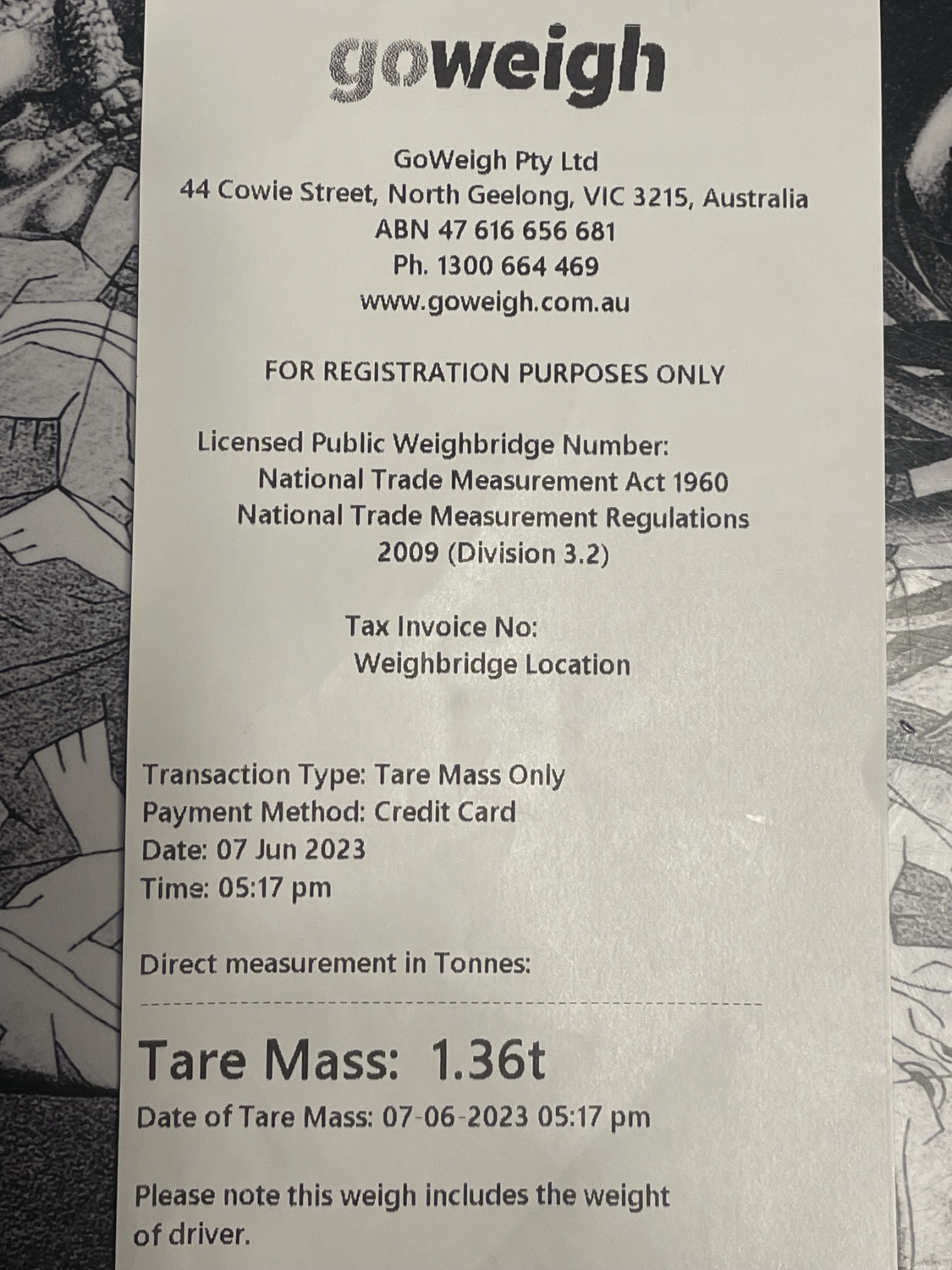
Many weigh bridges let you get both the front and rear axle loads. I didn’t park correctly to do this, as I used an automated weighbridge designed for much larger vehicles like long road trains, but you also should verify the axle weights front and rear as that’s the more often forgotten part of weigh limits. This is especially important if you’ve fitted a heavy bullbar and/or a heavy winch.
Calculating what it might weigh
If you’re looking to buy a Jimny and kit it out then this is going to be a requirement if you want to see where you fit with regards to the factory GVM and if you might want to consider a GVM upgrade. It also isn’t hard, even if it involves making a spreadsheet or adding up and subtracting a few numbers.
In calculating how close you might be to the factory GVM you need to:
- Catalogue the weight of any accessories you will add;
- Take off the weight of things you’ve removed from the car;
- Accurately account for your own weight and that of passengers; and,
- Whatever camping gear you want to take with you on a trip.
You add up all the things you’re adding to the car, and take away the things you’re taking off the car, and add that final number to the fully fuelled base weight of the car. At that point you have calculated the maximum vehicle weight given all accessories, fully loaded with you + passengers etc.
Point 1 is relatively easily covered by a spreadsheet of mods and weights compiled by one of the WA Jimny owners. Other accessories, like the weight of different Jimny wheels and tyres I account for in my writeup on wheel and tyre upgrades.
Some modifications don’t really involve any change in weight, e.g. a suspension lift adds negligible weight to the car unless you add things like a heavy-duty third crossmember or similar. Even then it’s a few kg, not 10s or 100s.
You also need to consider what weight you’re taking off the car, e.g. removing the rear seats from a 3 door saves 12 kg; fitting most bullbars involves about 8-10 kg of weight lost off the front of the car with the factory bumper and its brackets and so on. Even changing wheels and tyres you only need to account for the difference between a factory wheel/tyre and your chosen combination, as the factory wheel and tyre is taken into account with the base weight of the vehicle.
It’s important here not to lie about your own weight or that of passengers; you’re only fooling yourself. Obviously this needs to be a clothed weight not a naked after not eating anything for a week weight, either. Just like the car you won’t be going very far without fuel and adequate trip preparation…
Camping gear is the other big thing and this is where I think a lot of people discover they might need a GVM upgrade. If you carry a double swag (14 kg), a large gas burner (3-4 kg, plus a minimum of 10 kg for a small gas bottle), and a big large fridge then suddenly you’ve added a fair proportion of your payload just in a few items. I go into this a bit more about the choices you can make here in a second though.
Separate to the roof load limit of a max of 30 kg people also go for quite heavy roof platforms on the Jimny. Some of these can take up all of the roof load limit, and so it is worth doing some research as the 30 kg up there is also a fair whack of payload once you account for passengers in the car.
Ultimately you also need to understand that this calculated weight is likely the worst case scenario, assuming you properly account for everything. My certified weighbridge ticket is about 15 kg lighter than me calculating everything out based on what was in the car at the time, so clearly there’s some discrepancy around the theoretical versus actual weight of some mods. I’d trust the certified weighing device more than random specification weights on the internet. This is one of the reasons why weighing the car can be so useful.
Choices you can make to help out
The Jimny’s payload being in the mid 300 kg range means you need to start prioritising things especially if you’re going to have multiple passengers in the car. The Australian average adult weight is 87 kg male/72 kg female so two male and two female adult passengers = 318 kg. This puts even a stock Jimny basically at maximum payload just there, even before any accessories are added. This is where something like a trailer comes into its own for a camping setup, even with a 5 door Jimny.
On the flipside, if you’re just two adults and you don’t pack much camping then you’ve still got a couple of hundred kg to play with for accessories. While not a choice per se, it might influence your decision around a GVM upgrade or not, or if you can afford to add accessories.
The next main thing influencing your payload is your choice of accessories. Take, for instance, bullbars. Even in a looped bullbar to protect the upper radiator and also headlights can vary by more than 40 kg. The ARB bullbar weighs 45 kg but after accounting for factory bumper and bracket removal it is 37 kg added to the car all fitted. Contrast that to others that can weigh 60-75 kg. Even accounting for the removed weight this is still 15-30 kg on top of the ARB bullbar just from one single choice.
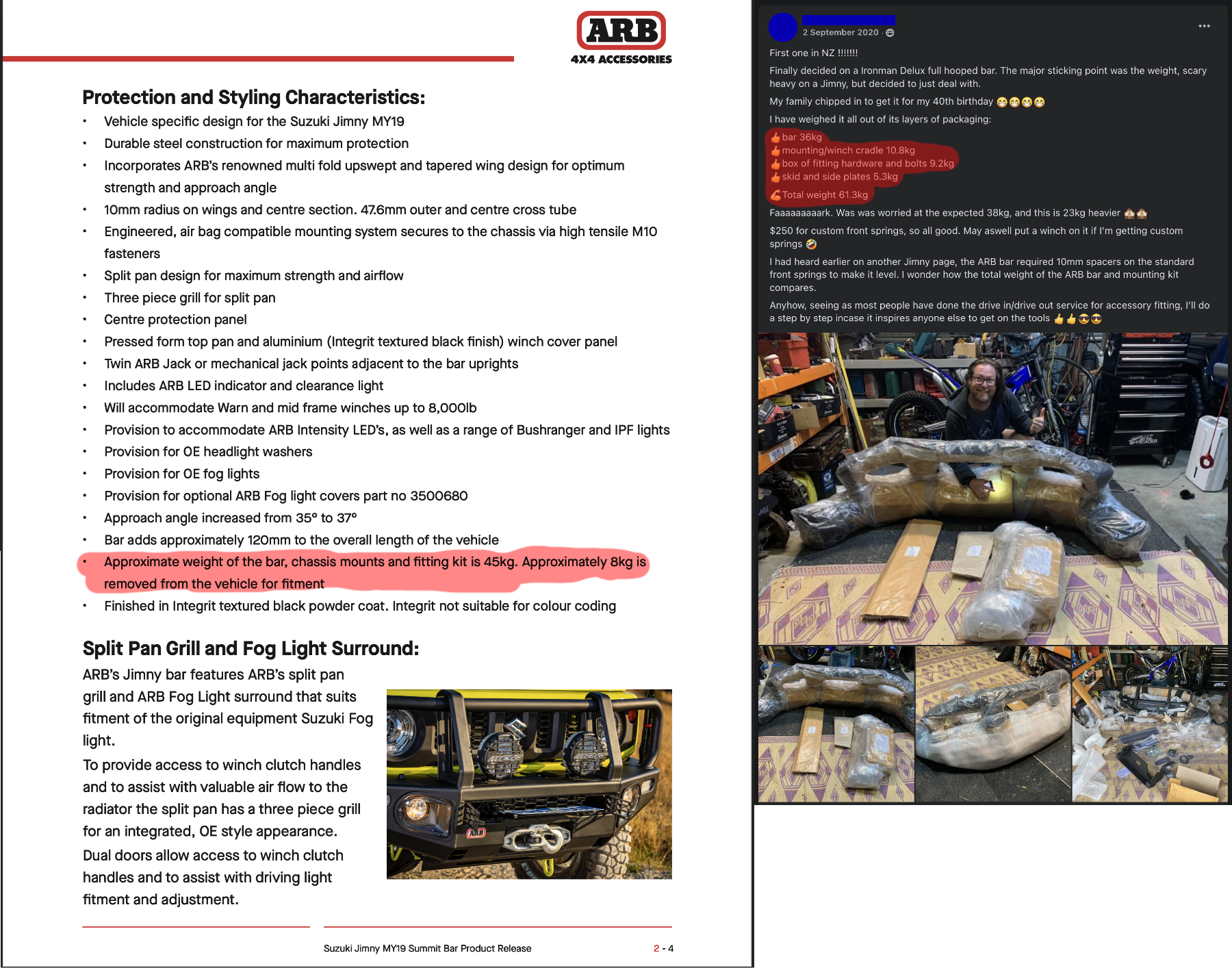
If you don’t need a bullbar, and arguments vary about their validity on a car with significant crumple zones as impacts will still crumple the car, then not even having one can be a big difference. While they give some benefit in approach angles by being higher off the ground and more angled than a factory bumper, that doesn’t necessarily offset the added weight.
Wheels and tyres can be one of the other major areas of weight differences.
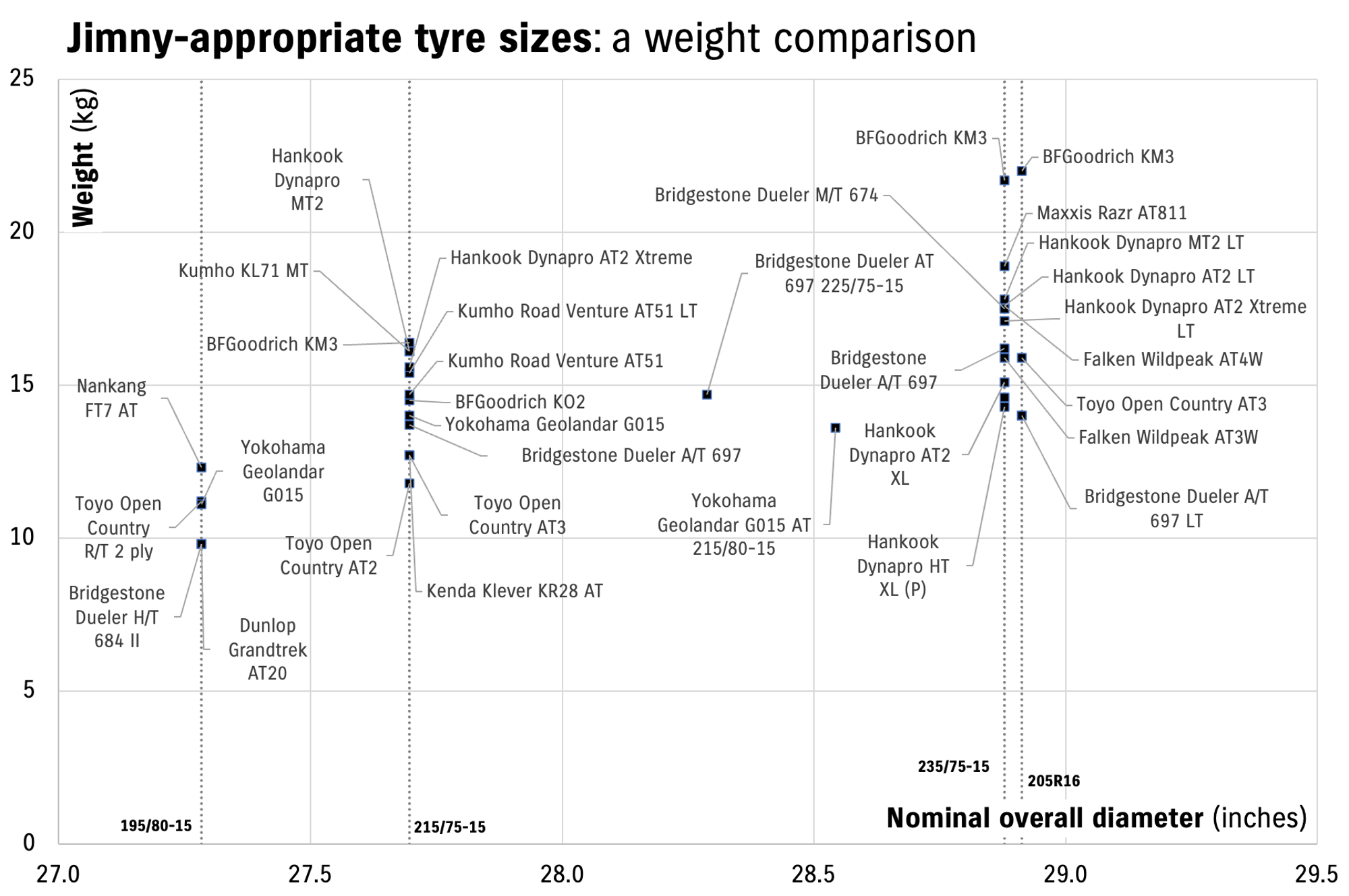
If you want to run a 29″ tyre (either 235/75-15 or 205R16) then you will be swapping wheels and tyres. A lightweight alloy wheel might be too lightweight for significant offroad use, but you only have a small weight penalty for many larger alloy wheels vs. a significant (~5 kg per wheel!) penalty going for a steel wheel. Same for tyres: the lighest 235/75-15 allterrain is nearly 4 kg lighter than the heaviest. Multiply that 9 kg per wheel/tyre difference by 5 wheels and that choice even for the same size/type of tyre and you’re 45 kg heavier. Given even the lighest setup would be 6 kg per corner heavier than standard then you’re looking at a payload reduction of 30 kg for the lightest setup or 75 kg for the heavier setup.
That isn’t to say lightness is everything, either, when it comes to wheels or tyres. Offroad you might want a more aggressive or higher ply tyre option so you have stronger tyres or something better suited to the terrain you do. Steel wheels have benefits of repairability when bent that also might make it more suitable for you. It just means you need to pick wisely and there are implications for the choices you have made.
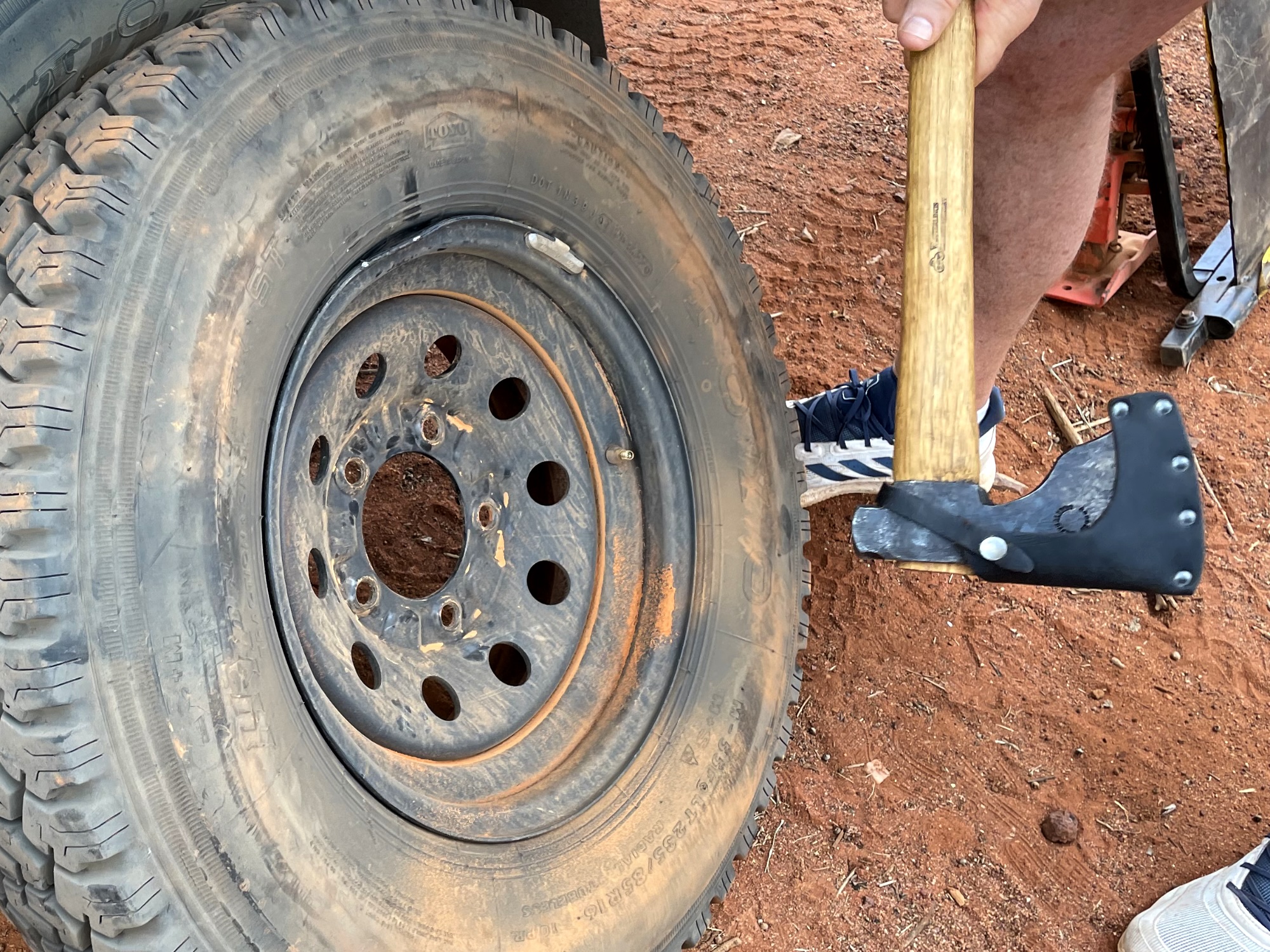
Another area where people suffer with payload is in heavy camping equipment. This is all a personal preference but you can make big weight savings here in either what you bring for camping or what you choose to eat or drink. Fridges can vary significantly, and if you can do without (e.g. using mini UHT milks, taking dehydrated or freeze dried meals etc) then you can save 15-30 kg just there (plus no need for an additional battery). A hiking tent might be 2 kg plus another kilo for sleeping bag and mat, whereas bedding and a double swag can be 15-20 kg. All of those sorts of things add up significantly.
I don’t think people need to go as minimal as my setup, but it’s possible to do a multi-day trip very, very lightly.
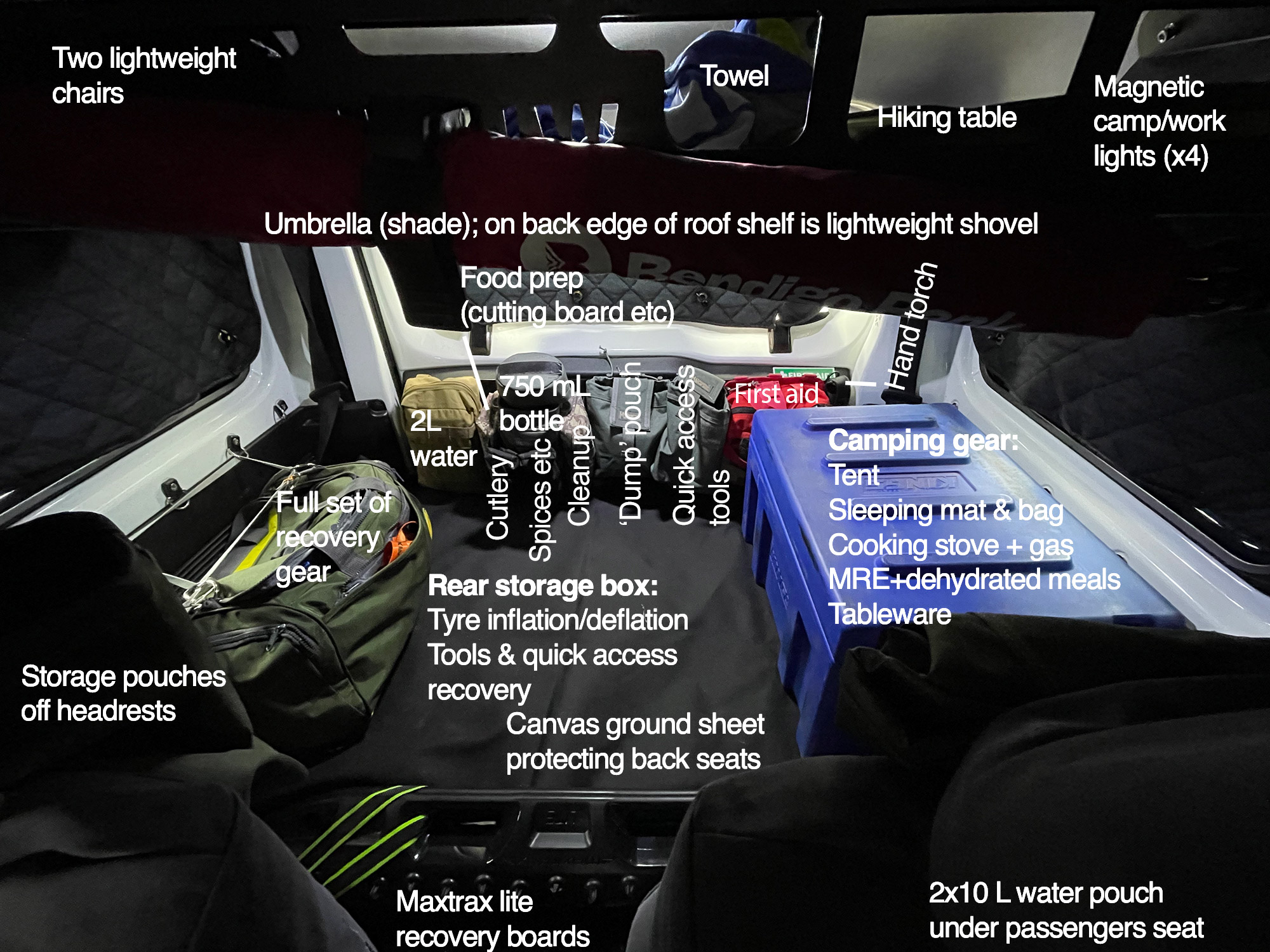
As a practical example, even with things like a bullbar and winch, here’s how a couple of mod breakdowns might look. I’ve not even gone for the most heavyweight setup e.g. not the heaviest roof platform for the heavier setup.
| Lightweight setup | Heavy setup | |
|---|---|---|
| Bullbar | 37 kg (ARB) | 52 kg (Ironman) |
| Winch | 15 kg (ATV 4500 lb unit) | 32 kg (12,000 lb winch) |
| Fridge | 0 kg (none) | 20 kg |
| Larger starter battery to run winch | 5 kg | 15 kg |
| Auxiliary 12v system | 0 kg (none) | 15 kg (50 Ah battery, charger, bracket) |
| Camping gear | 4 kg (hiking tent etc) 15 kg (food, water, wine) | 15 kg (swag) 25 kg (food, water, beer) |
| Camp shelter | 8 kg (quickshade, carried in car) | +15 kg (270º awning) +20 kg (roof rack) |
| 29″ tyres & wheels to suit | +27.5 kg over stock (alloy 16″ wheels, 205R16 tyres) | +62 kg over stock (steel wheels, AT811 tyres) |
| False floor/rear setup | Rear seat delete, new false floor -4 kg over stock | Metal framed false floor Metal drawers +30 kg over stock |
| Driver | 90 kg | 90 kg |
| Passenger | 65 kg | 65 kg |
| Total payload: | 263 kg | 421 kg |
Out of these two theoretical setups you’re looking at something comfortably within the factory GVM of 1435 kg / payload of 325 or 340 kg and something that won’t.
